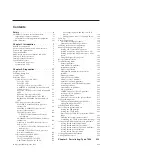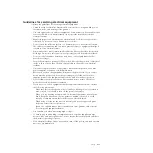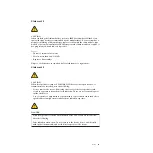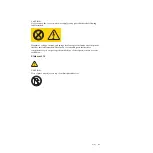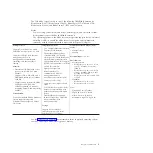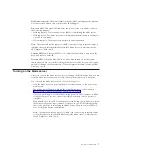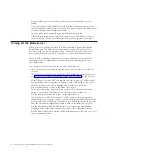
Antes de instalar este producto, lea la información de seguridad.
Läs säkerhetsinformationen innan du installerar den här produkten.
Guidelines for trained service technicians
Inspect the equipment for unsafe conditions and observe the servicing guidelines.
Inspecting for unsafe conditions
Identify potential unsafe conditions in an IBM
®
product that you are working on.
Each IBM product, as it was designed and manufactured, has required safety items
to protect users and service technicians from injury. This information addresses
only those items. Use good judgment to identify potential unsafe conditions that
might be caused by non-IBM alterations or attachment of non-IBM features or
options that are not addressed in this information. If you identify an unsafe
condition, you must determine how serious the hazard is and whether you must
correct the problem before you work on the product.
Consider the following conditions and the safety hazards that they present:
v
Electrical hazards, especially primary power. Primary voltage on the frame can
cause serious or fatal electrical shock.
v
Explosive hazards, such as a damaged CRT face or a bulging capacitor.
v
Mechanical hazards, such as loose or missing hardware.
To inspect the product for potential unsafe conditions, complete the following
steps:
1.
Make sure that the power is off and the power cords are disconnected.
2.
Make sure that the exterior cover is not damaged, loose, or broken, and observe
any sharp edges.
3.
Check the power cords:
v
Make sure that the third-wire ground connector is in good condition. Use a
meter to measure third-wire ground continuity for 0.1 ohm or less between
the external ground pin and the frame ground.
v
Make sure that the power cords are the correct type.
v
Make sure that the insulation is not frayed or worn.
4.
Remove the cover.
5.
Check for any obvious non-IBM alterations. Use good judgment as to the safety
of any non-IBM alterations.
6.
Check inside the computer for any obvious unsafe conditions, such as metal
filings, contamination, water or other liquid, or signs of fire or smoke damage.
7.
Check for worn, frayed, or pinched cables.
8.
Make sure that the power-supply cover fasteners (screws or rivets) have not
been removed or tampered with.
vi
JS12 Type 7998: Problem Determination and Service Guide
Summary of Contents for BladeCenter JS12
Page 1: ...BladeCenter JS12 Type 7998 Problem Determination and Service Guide...
Page 2: ......
Page 3: ...BladeCenter JS12 Type 7998 Problem Determination and Service Guide...
Page 14: ...xii JS12 Type 7998 Problem Determination and Service Guide...
Page 248: ...234 JS12 Type 7998 Problem Determination and Service Guide...
Page 252: ...238 JS12 Type 7998 Problem Determination and Service Guide...
Page 290: ...276 JS12 Type 7998 Problem Determination and Service Guide...
Page 298: ...284 JS12 Type 7998 Problem Determination and Service Guide...
Page 302: ...288 JS12 Type 7998 Problem Determination and Service Guide...
Page 312: ...298 JS12 Type 7998 Problem Determination and Service Guide...
Page 317: ......
Page 318: ...Part Number 60Y1568 Printed in USA 1P P N 60Y1568...





